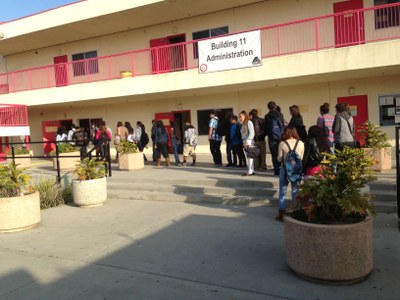Tardiness Reduction Leadership Project
Rationale
In the past my school has experienced trouble with absenteeism, tardies, student dropouts and poor student performance across disciplines. Many of the aforementioned issues are complex and systemic and need to be addressed. As a teacher, tardies and absenteeism have made a tremendous impact on my ability to maintain my instructional momentum.
Continual tardiness is detrimental to instructional momentum and places the student at a disadvantage. Students are late for a variety of reasons and many of these reasons are circumstantial and out of the control of the student. This issue is directly related to social justice because students are punished for excessive tardiness regardless of why they are late. Also only a minimal amount of research has conducted in order to determine why students are late. In addition, students that live in the inner city and attend inner city schools overcome a variety of obstacles (transportation, family related, etc.) as they attempt to come to school on time. I am hypothesizing that the development of an intervention plan will work to reduce incessant tardies, which lead to classroom disruptions, low achievement, and low student morale. This plan will work to strategically sustain a culture of success and improve academic achievement, which may lead to higher grades. I plan to reach out to parents, community members, and instructional leaders to implement a campaign that will work to lessen the impact of tardiness and absenteeism. The aforementioned issues led me to seek options to reduce tardiness. I feel that tardies and absenteeism are issues that need to be addressed due to the fact that students who are continually tardy lose critical instructional minutes, which may lead to a decrease in academic performance.

Summary
My Goal:
- Find students who have a high frequency of tardiness, interview them and find out why they are tardy (find the root causes).
- Schedule weekly conferences with students and parents as means to open up dialogue and find the root of why the student is consistently late.
- Offer students incentives if they can reduce their tardy rate.
- Work with teachers to track student tardy rates and identify the issues that cause students to arrive to school late.
- Host Professional Development as a means to introduce the results of my research and discuss strategies that will work to reduce tardiness campus-wide.
- Develop a school-wide protocol that will address student tardiness daily
- Reduce Tardiness and Preserve Instructional Time
My idea was to create an on-sight intervention program for tardy students that will work to persuade them to come to class on time. So I designed a plan that will allow me to pinpoint the root causes of Tardiness on the Hawthorne High School Campus. Originally my plan was to interview and work with a small group (cohort) of students who were incessantly tardy but my plan has developed and changed. After speaking with students and parents in order to determine the root causes of tardiness, I realized that the tardiness issue was more complex and required more research. I began to speak with administrators and teachers; these conversations led me to question whether the issue of tardiness was strictly an issue that was linked to student apathy and irresponsibility. I began to look closely at attendance data and I realized that there were two main groups that stood out within my data. These two groups consisted of tardy students (mostly tenth graders) and teachers who share a disproportionate amount of tardy students.
The data that I collected and analyzed led me to explore new questions and create a more developed focus. My focus was now centered around teacher actions and their relation to student tardiness. Even though there were many examples of tardiness that could be attributed to students and parents; many other examples pointed to classroom norms and teacher practices that dealt either directly or indirectly with student tardiness. For example, I began to ask students new questions to determine if some of their teachers were strict (in regard to this rules addressing student tardiness) or if there were classroom norms that discouraged students from coming late. One student (10th grade male) noted that his teacher would consistently give out a graded warm-up at the beginning of each class, which became a significant part of his grade over the course of the class. He admitted that the consistency of the teacher’s curriculum and established norms led him to come to class on time. Another student (11th grade female) mentioned that it was not a big deal if she came in late, instead of going straight to class she would linger around and eventually go to the attendance office and get a tardy slip. Another student (11th grade male) mentioned that his teacher rarely said anything to him as he walked into the door late and that being tardy is just not a big deal. After gathering conversational as well as numerical data I began to change the focus of my inquiry so that it is centered-around encouraging teachers to use consistent practices to address tardiness. Going forward my goal is to create a safe space where the issue of tardiness can be addressed and new solutions can be presented by a series of stakeholders including teachers, parents, counselors, and administrators. I will host a meeting where I will present my findings to a group of stakeholders and subsequently facilitate a discussion will further address the problem and lead to possible solutions and or compromises that entail refocusing teacher practices.
The concrete tools that have helped to further develop my project have been surveys and questionnaires that fully address the issue associated with student tardiness. In addition gaining access to the administrative side of PowerSchool has allowed me to accurately track student and teacher attendance data. Furthermore having access to student records allowing me to seek out students so that I may ask them questions about school related feelings and behaviors.
Prior challenges relating to this project have dealt with my ability to gain access to documents and data that I needed to start my project. Potential challenges include exposing data that may make some administrators and teachers uncomfortable especially if the findings show that their practices may have exacerbated campus tardiness among Hawthorne High School's student population.
Professional Development

At my initial professional development meeting I shared the results of the research. My research indicated that most of our students are tardy in the morning for personal reasons and that they were tardy throughout the day due to lack of tardy enforcement and many students felt that the first ten minutes of class were not important. I presented my findings with teachers and my finding generated a discussion that led us to develop several ideas to further reduce tardiness on our campus. From this discussion we generated three practices that teachers could implement (campus-wide) that would help teachers reduce tardiness in their classes (Listed Below).
Methods to Improve Student's Punctuality
1. It is important that all teachers stand at their doors in the morning to greet students and encourage students to move to class. Standing at your door can allow you to spot students who are loitering outside or taking their precious time to enter the classroom.
2. It is important that teachers consistently engage students with a relevant warm-up during the first ten minutes of class. Students are more likely to come on time if the first ten minutes of class is engaging and/or important to their overall success in a class.
3. Make tardiness an issue in your class. Encourage students to come to class on time and acknowledge those who come on time even if they are normally late. Positive encouragement can lead to a change in student behavior.
Changes
If I had an opportunity to start over I would have fully developed my questions first and those initial questions would have focused more on teacher responses to tardiness instead of student’s reasons for tardiness. In addition, part my challenge deals with the fact that I wasn’t able to begin my project during the beginning of the school year, since I was new to my campus. Since I arrived at my school site late in the year it took me quite a while to build the relationships that I needed to get started on this project. I will continue this project into the next school year and I will begin my implementation on the first day of school.
Supporting Documents
Fishbone Diagram - Early Planning Stages
Improving Student's Punctuality - Campus-Wide Measures
CPSEL’s Addressed:
CPSEL Standard 2
Advocating, nurturing, and sustaining a school culture and instructional program conducive to student learning and staff professional growth.
- 2.1 Develop school culture and ensure equity
- 2.4 Create and utilize accountability systems
CPSEL Standard 4
Collaborating with families and community members, responding to diverse community interests and needs, and mobilizing community resources.
- 4.1 Collaborate to incorporate the perspective of families and community members
- 4.2 Establish and manage linkage between the site and the larger community context
CPSEL Standard 6
Understanding, responding to, and influencing the larger political, social, economic, legal, and cultural context.
- 6.1 Engage with the policy environment to support school success
- 6.2 Interact with stakeholders

